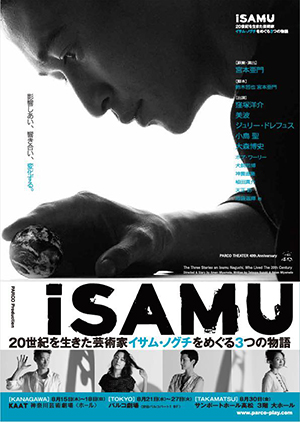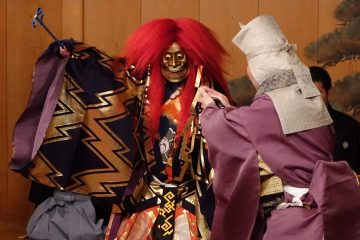"iSAMU" Three stories about Isamu Noguchi, an artist who lived in the 20th century

"iSAMU" Theater Report
2013.8.15/Maureen
On this day, the anniversary of the end of the war, I had the opportunity to watch the dress rehearsal of "iSAMU" at KAAT Kanagawa Arts Theatre.
Isamu Noguchi, an American with American nationality, is more Japanese than the Japanese themselves, and loves Japanese beauty to the point of sometimes becoming overly obsessed with it.
However, he was denied the opportunity to create a monument at the Hiroshima Peace Memorial Park because he was "American."
Who am I?
The opening scene features a memorable conversation with a flight attendant on the plane, in which she asks whether he is "going" to Japan or "returning" to Japan.
This casual conversation gave us a sense of some of the conflicts in Isamu Noguchi's life, making the entire play very easy to watch.
Three stories progress simultaneously, but the stylish use of images and sound creates an interesting mix of time and space.
My favorite scene is when a modern-day man and woman are eating sandwiches, looking at Isamu's work, and talking freely about what exactly this work is.
No matter how silly their ideas are, they are all correct, and best of all, the two of them look like they are having a lot of fun talking about them.
I couldn't help but think that Isamu, the creator, was probably watching this scene with a grin from heaven.
Yosuke Kubozuka, who plays Isamu, is wonderful in the way he matches his slender foreign style with the stoic and naive aura of an artist.
Rosanjin, played by Omori Hiroshi, is the only character in the play who really lightens the mood, and the audience feels relieved when he appears.
I felt the same frustration as the woman played by Kojima Seiya.
The interactions between her and her foreign lover are exquisite and very funny.
In all three stories there is a misunderstanding between the characters.
I realized that what I want might actually be the thing I am least able to give to others.
At the end, each actor releases warm-colored lights into the sky, reminiscent of Isamu's work "Akari."
The curtains close on the stage, sending off a beautiful light that looks like the moon and also resembles the number "zero," the play's keyword, which holds eternal possibility.
To me it looked like a moment when life and death were connected, but I wonder...
The entire stage was beautifully and creatively produced, allowing us to enjoy a wonderful artistic space.
/////////////////////////////////////////////////// //////////////////////////
Maureen
Born in 1991
Currently studying acting at the university's drama department.
I love looking at beautiful things.





